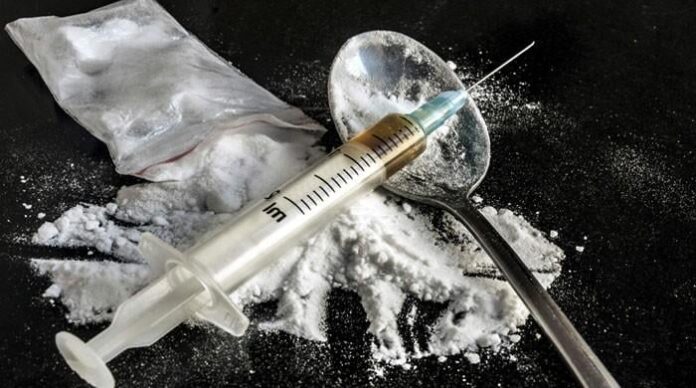BY Dr. Sahibzada Muhammad Usman
With the presence of large numbers of Indian troops, paramilitary, police, and agency men in every corner of Indian Illegally Occupied Jammu Kashmir (IIOJK), the number of drug cases has been on the rise, indicating that the Indian police and military establishment support drug mafia remains to corrupt the youth of Kashmir valley. According to official statistics, 31675 incidents were recorded under various types of crime in 2021, compared to 28,936 incidents in the same year in 2020, indicating a 9.47% increase.
According to the Indian Ministry of Family Welfare, the crime rate for 2021 will continue at 235.68, as opposed to 2020’s rate of 216.90. Based on the data, in 2021, property worth Rs 36 crore was stolen, whereas Rs 14.79 crore was reclaimed, for a recovery rate of 39.86 percent. About 3873 crimes against women were reported, compared to 3517 in 2020. In 2021, 1681 Narcotics and Drugs cases were filed, up from 1222 in 2020, indicating an upward trend. Since the IIOJK has been in conflict for more than 20 years, there have been more psychiatric disorders and psychological problems. Numerous psychiatric disorders, such as Depression and Drug Addiction, have emerged. Concerning the issue of drug addiction in IIOJK, it has been reported that this turmoil region has seen a significant increase in drug abusers over the previous decade.
According to the United Nations Drug Control Program (UNDCP), the IIOJK has approximately 70000 heroin addicts, including 4000 females. Several local reports showed that teens and young adults, especially those between the ages of 17 and 30, are involved in this problem. Government Psychiatric Hospital claimed that most drug use cases are extremely young. Dr. Khan, in charge of the Drug De-Addiction Clinic in Srinagar, said drug abuse among teenagers is rising. He said that there had been many reports of teens in Classes IX to XII abusing drugs.
In one of their books, Drs. Maqgoob and Dutta mentioned that there are 2.11 lakh drug users in IIOJK valley. S.P. tablets, Anxiety, Heroin, Brown Sugar, Alprax, Inhalants, Cannabis, like Dirty Socks, Paint Varnish, Shoe Polish, Fevicol, and Thinner are the most popular substances used by drug users in IIOJK. Because of how quickly this danger is getting worse in Kashmir, academics and government officials say that we have wasted one generation on gunfire and may waste another on drugs.
Margoob and Dutta discovered that most drug users are men, and cannabis is their primary addiction substance. In his study, young people use drugs mainly because of Indian military unlawful activities, unemployment, and violence. Multiple studies have shown that 80 percent of drug users are addicted before the age of 30. This research found that more than 90 percent of individuals are unaware of the drug de-addiction process, and only 8 percent are aware of the drug de-addiction center in Srinagar, Kashmir. In another significant piece of research, Mushtaq found that around 90 percent of drug abusers are polyabusers. A polyabuser is a person who simultaneously uses two or more substances, such as a cannabis user who also uses heroin, alcohol, or any other substance. They also observed that the average starting age is between 11 and 20. Social pressure by the Indian military has been summarized as the primary cause of drug addiction, with 78% of drug users revealing that they resorted to drugs due to peer pressure. People have also said that drug addiction is caused by wanting to feel good or getting away from bad feelings.
This dark picture of drug abuse in the Kashmir Valley has caused much trouble for the people there. The unlawful trafficking and sale of narcotics inside the valley present the most significant obstacle, in which the police and military play a crucial role. Recent reports indicate that many opioid crops are being cultivated in Kashmir, making the drug available, and other psychotropic drugs are also freely available. The other obstacle is the limited availability of drug recovery centers. More drug rehabilitation centers are required to treat the victims. Lack of knowledge about drug addiction and the detoxification and therapy processes is another obstacle. Government agencies, schools, non-government organizations, and other organizations must educate the public, especially the younger people. Awareness on the part of parents and caregivers must also be addressed so that they may recognize this issue as early as possible and offer prompt assistance to the individual. A victim might be able to deal with this threat by getting more social support and teaching him or her good habits. Drug addicts often feel alone and left out, so giving them social and spiritual support gives them the power to stop using drugs. Furthermore, the Indian military should stop unlawful actions and backing of drug suppliers because this brings another big problem for the youngster of IIOJK.
About Author:
Dr. Sahibzada Muhammad Usman
Research Scholar and Academic; Assistant Professor in the Department of Strategic Studies at Air University, Islamabad, Pakistan. Ph.D. in Political Science at the University of Pisa, Italy. Dr Usman has participated in various national and international conferences and published 30 research articles in international journals.






